Let‘s make Pickled Sushi Ginger (or Gari ガリ) at home! It’s easy and simple to do. Refreshing and slightly sweet, it‘s perfect for cleansing your palate as you enjoy delicious sushi.
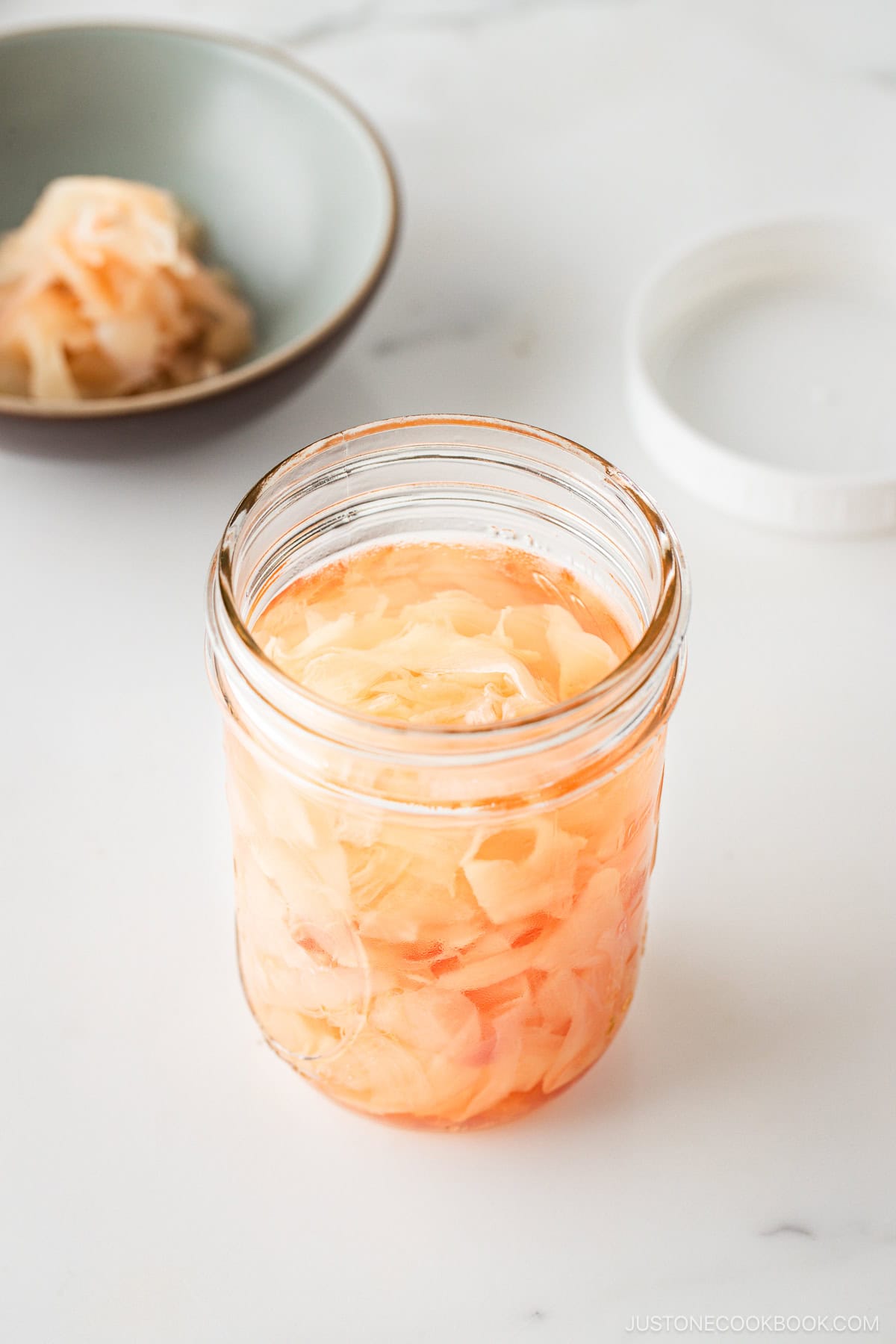
If you enjoy my sushi recipes like Hand Roll Sushi, California Roll, Dragon Roll, and Spicy Tuna Roll, there’s one essential complementary item you need to enjoy with your amazing sushi. And that’s pickled sushi ginger, also known as gari. Let me show you how easy it is to make this delicious pickle at home!
Table of Contents
What is Pickled Sushi Ginger?
In Japan, we call pickled ginger gari (ガリ) or shin-shoga no amazu-zuke (新生姜の甘酢漬け). They are very thin slices of young ginger soaked in sweet vinegar brine (amazu) until blush pink in color. The name gari is an onomatopoeia for the crunching sound of a knife thinly slicing the ginger!
We often serve and eat pickled ginger while eating sushi. It’s an essential part of a sushi meal. The spiciness and sweet vinegar flavor serve as a palate cleanser between courses, allowing you to enjoy different pieces of fish and rolls.
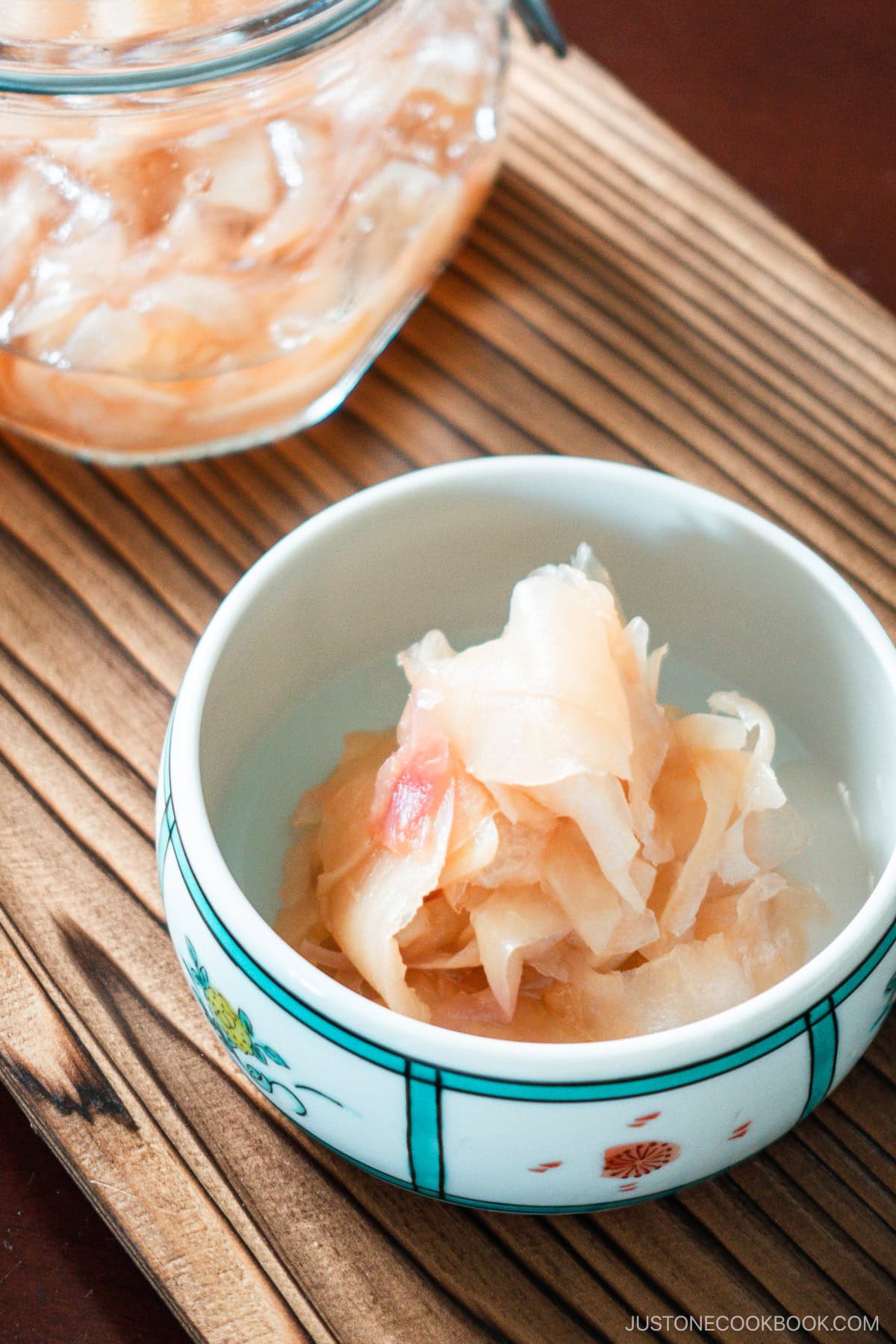
What are Sweet Pickles or Amazuzuke?
There are many types of pickles that we call tsukemono (漬け物) in Japan. We call the sweet type amazu-zuke (甘酢漬け). For the pickling solution, you just need 3 ingredients. Simply put rice vinegar, sugar, and salt in a saucepan and boil, then let cool. You can keep it in the refrigerator for 2-3 months to use in batches.
Do you need to use rice vinegar? Ideally, yes. The taste is mellow, milder, and more refreshing compared to the other types of vinegar. Because of that, you can use less sugar. You must add more sugar if you use another type. For authentic Japanese flavor, go with rice vinegar!
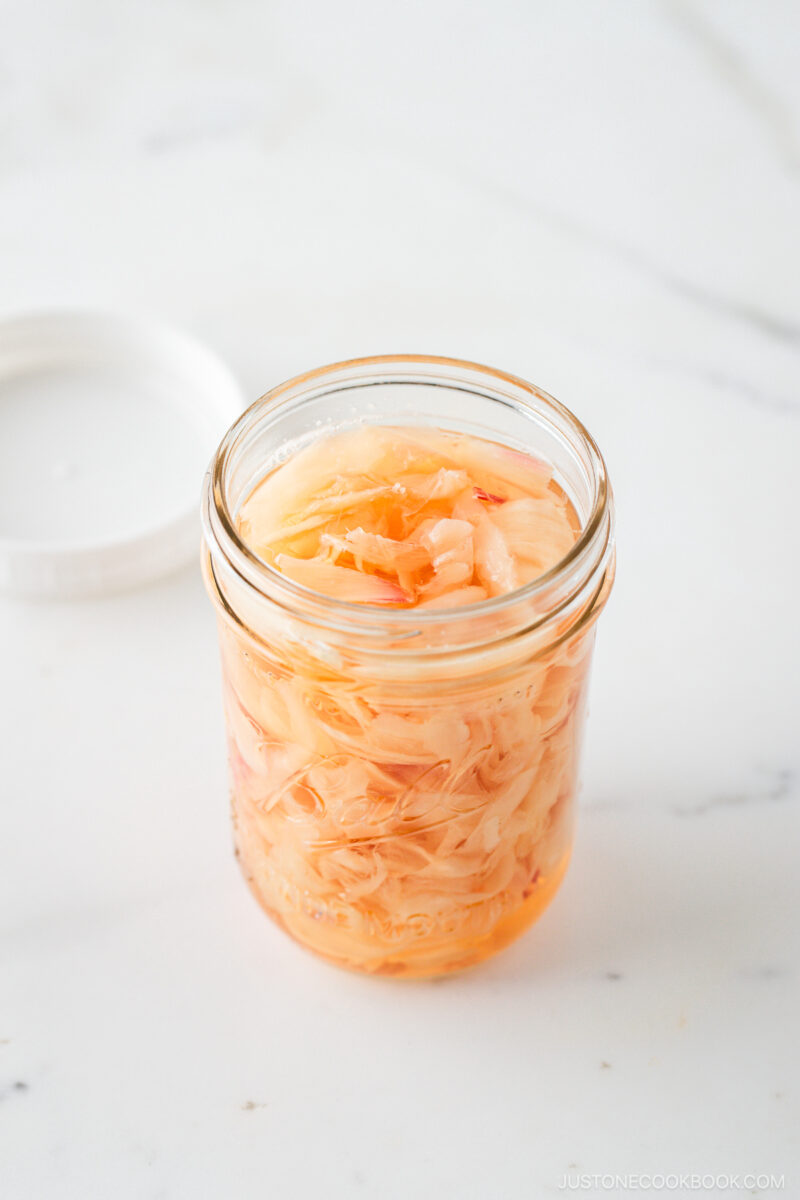
Ingredients for Pickled Sushi Ginger
- young ginger – we’ll talk more about this later
- salt – roughly 3–5% of the ginger weight; I use kosher salt
- rice vinegar, sugar, and salt – for the sweet pickle solution (amazu)
If you use white granulated sugar, the pickling solution will be lighter in color and showcase the pink more visibly (see the image below).
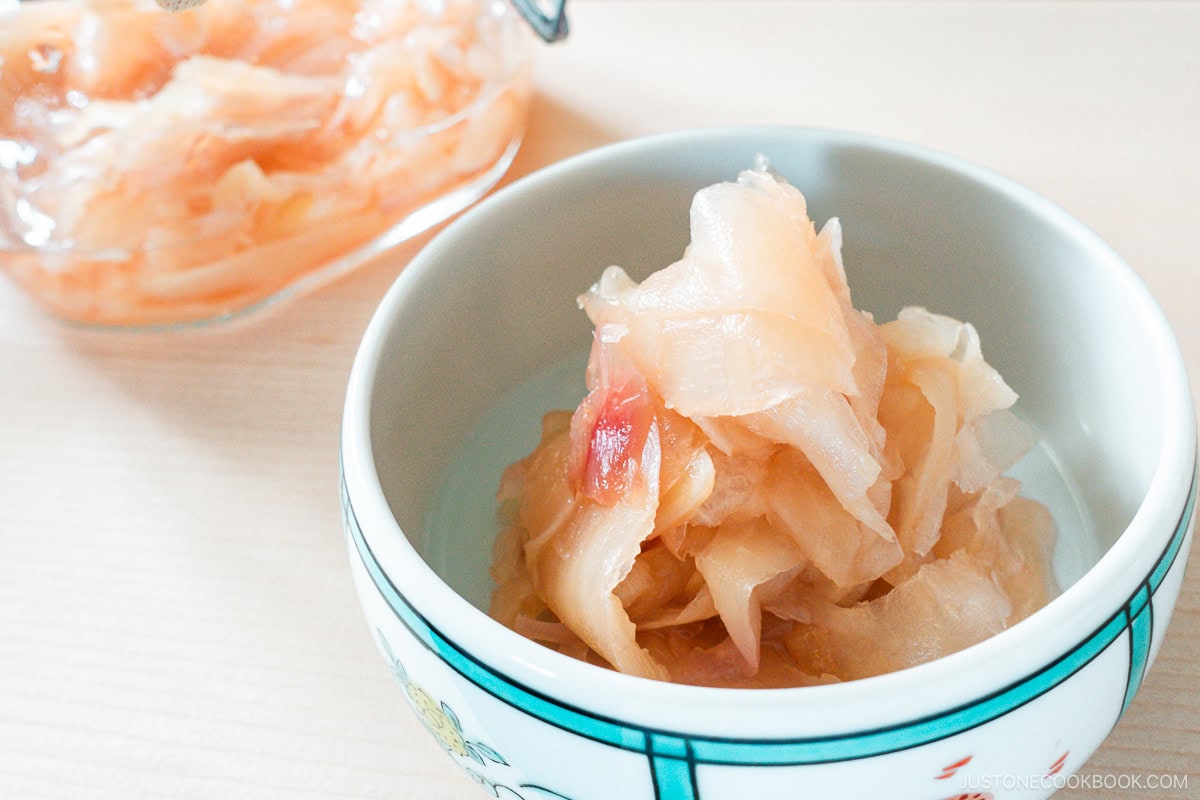
How to Make Pickled Sushi Ginger
This recipe takes just 20 minutes of prep and cook time and a minimum 4 hours of pickling. Here’s an overview, but see my recipe below for full instructions:
- Thinly slice the ginger with a vegetable peeler (this is what I use) or a mandoline slicer. Sprinkle with salt and let it sit for 5 minutes.
- Blanch the sliced ginger in a medium pot of boiling water for 1-2 minutes. Drain.
- Let cool slightly. Spread out the pieces of ginger on a rack to cool and dry a bit. Squeeze the liquid out and put in a sterilized jar.
- Make the sweet pickle solution. Stir the ingredients in a pot and bring to a boil. Cook until the strong vinegar smell evaporates and the sugar dissolves.
- Pour the hot pickling liquid into the jar of ginger. Pickle in the refrigerator for a minimum of 4 hours. Enjoy it the next day or later for even better flavor.
It’s easy to make, and lasts up to a year! If you can get young ginger, make a big batch and keep it for future sushi meals.
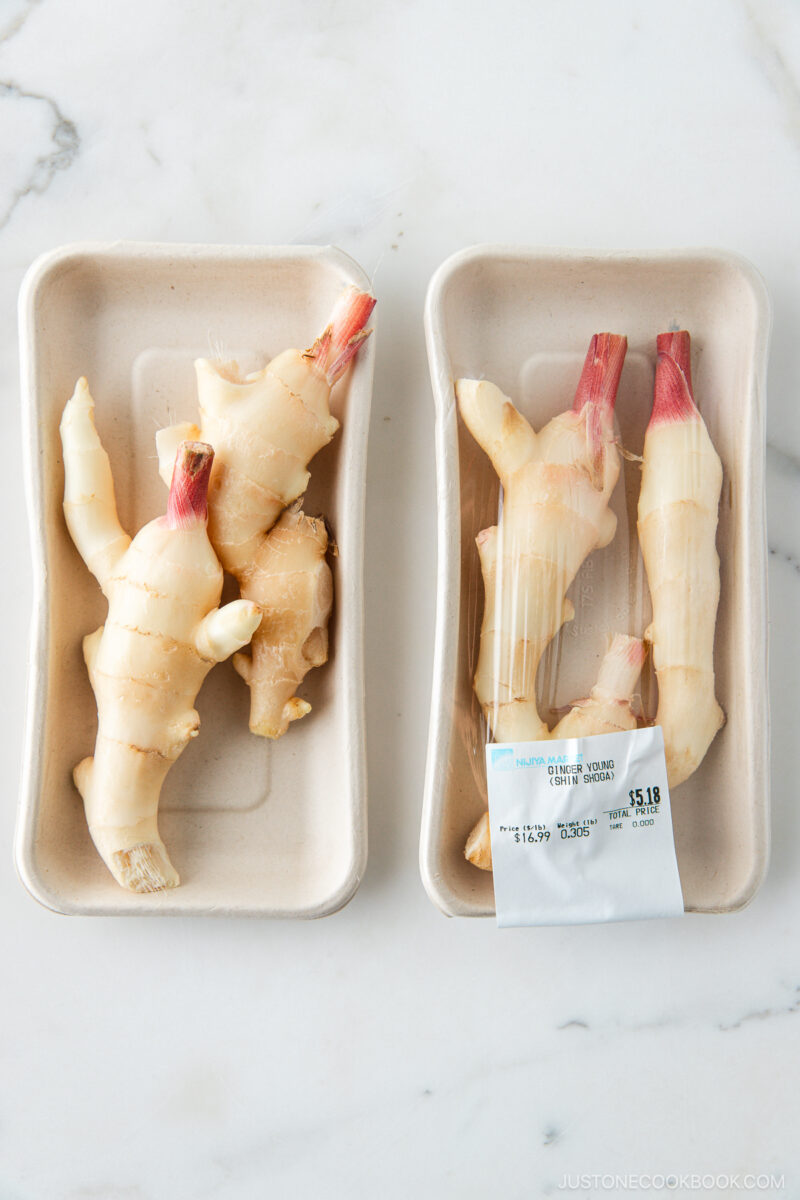
Why Use Young Ginger?
Young ginger has a mild, zesty flavor and a fine fleshy texture. It’s tender and perfect for sushi ginger. Unlike matured ginger, the young ginger’s skin is very thin and easy to peel with your fingers or a spoon.
Sliced young ginger will naturally become light pink from the tips of the young ginger (see the photo below). Many commercial producers artificially dye the pickled ginger pink. If you purchase pickled sushi ginger, you can find some brands that avoid artificial coloring.
Young ginger is harvested and sold in early summer around May or June. You can find it in Asian grocery stores, but sometimes the pink tips are already cut off. You can still make pickled ginger with these, but they won’t be naturally pink.
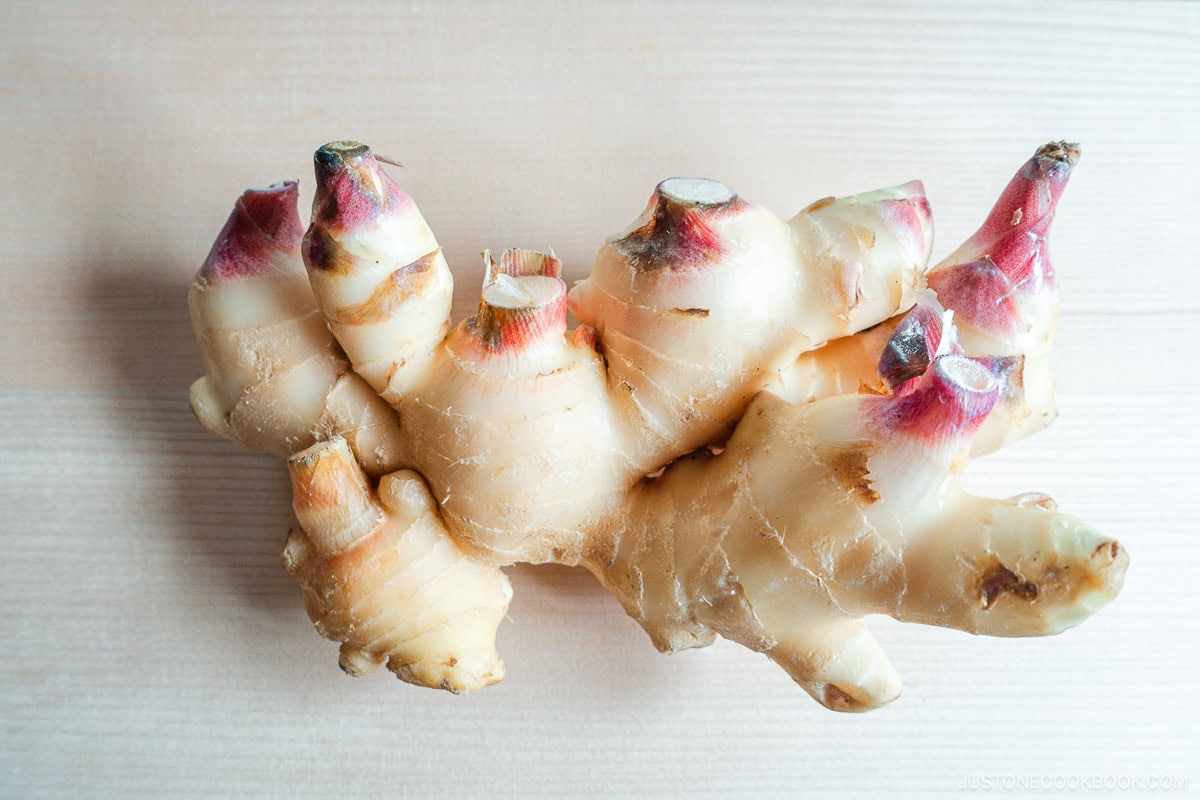
Where to Find Young Ginger
- Japanese/Asian grocery stores
- Farmers markets
- Etsy (I’ve purchased young ginger from Hawaii before)
- Good Eggs
FAQs
Can I use less sugar?
No. The ginger will not preserve well if you use less sugar. The least you can use is ½ cup of sugar for one batch of this recipe, and it is still quite tangy. If you prefer the taste of store-bought sushi ginger, use the higher amount of sugar indicated.
Can I substitute a different vinegar?
You can, but you’ll have to add more sugar if you use another type. By comparison, unseasoned rice vinegar is more mild, so it requires less sugar. As I mentioned earlier, use rice vinegar for an authentic Japanese flavor.
Can I use regular, mature ginger?
If you use regular ginger, it will be very spicy. To reduce the extra spiciness of the ginger, you must boil it longer than young ginger. I recommend blanching it in a pot of water for 2-3 minutes.
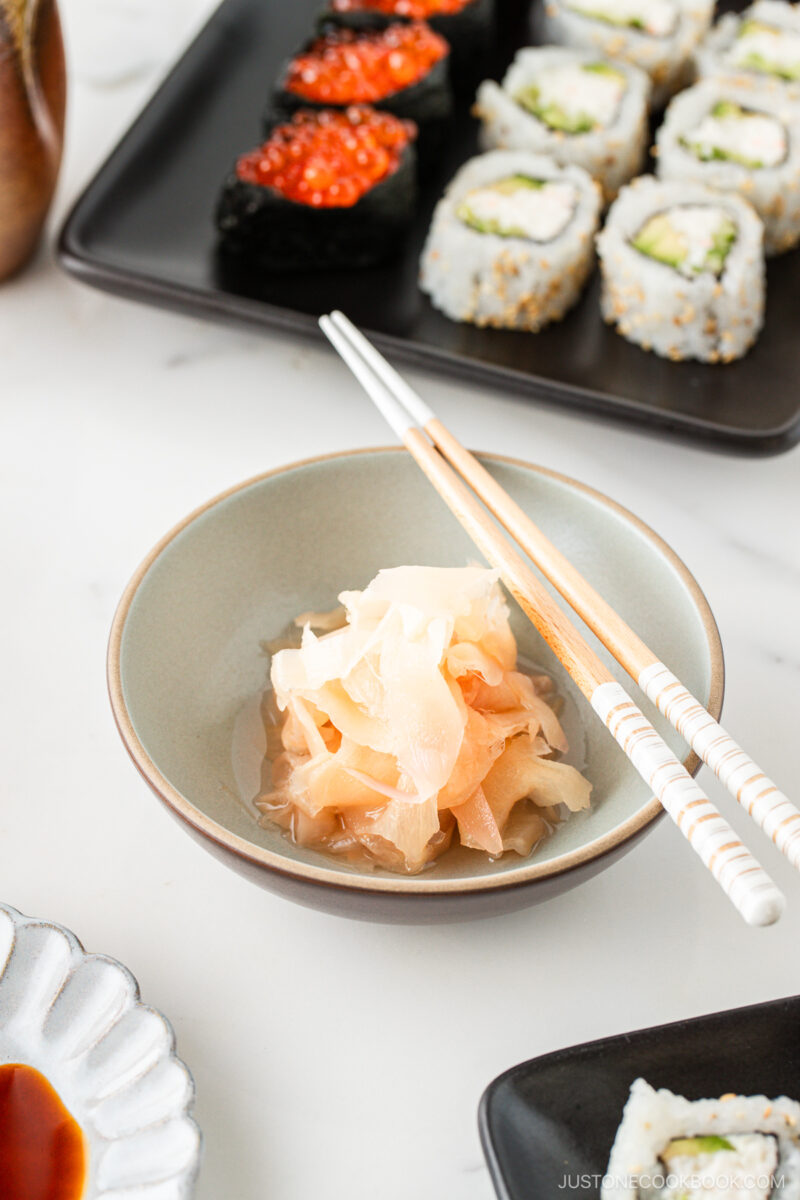
What to Serve with Pickled Sushi Ginger
When you find young ginger in the grocery store, you know what to do now! I hope you enjoy this homemade pickled ginger recipe.
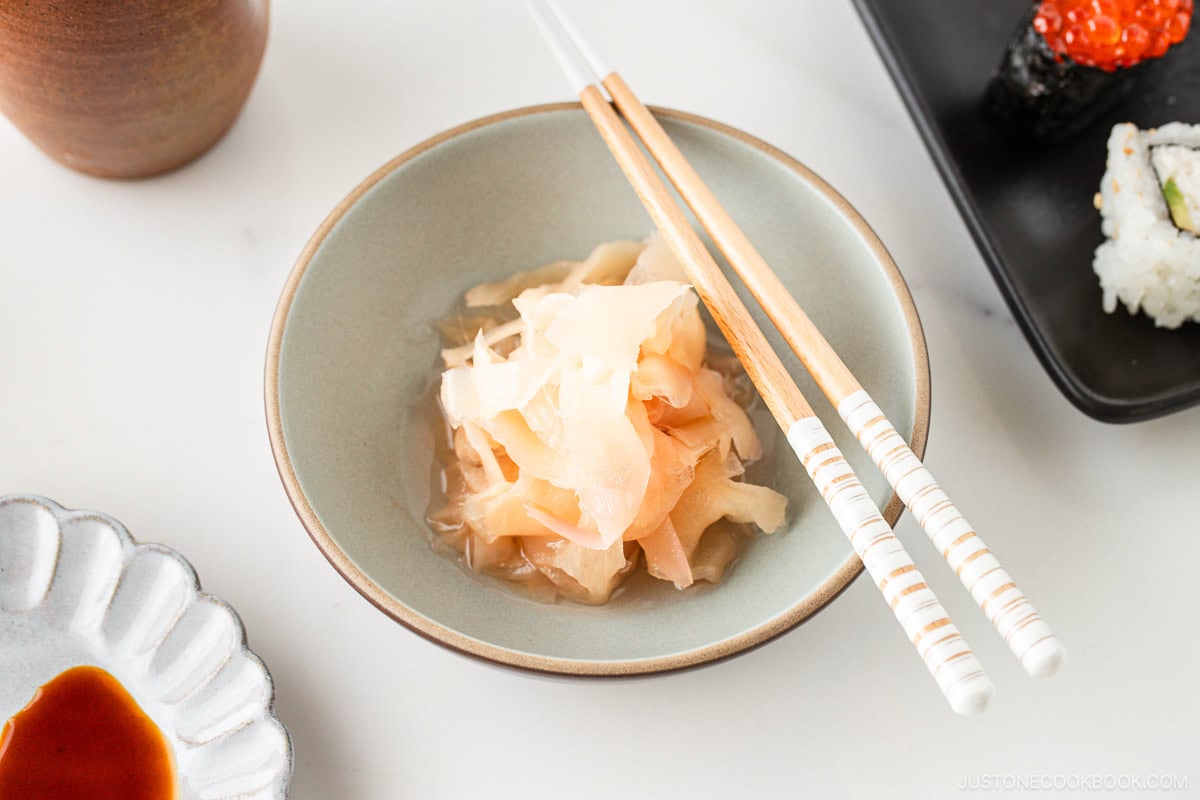
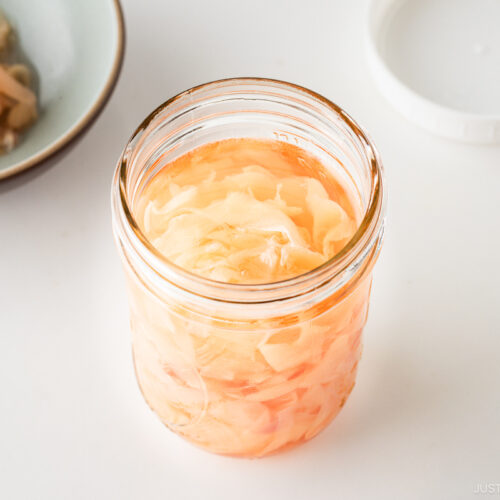
Pickled Sushi Ginger (Gari)
Video
Ingredients
- 8 oz young ginger (you can increase by up to 50% for this recipe; if you use regular ginger, it will be VERY spicy and you must boil it longer to reduce the spiciness)
- 2 tsp Diamond Crystal kosher salt (3–5% of the ginger‘s weight)
For the Sweet Vinegar (Amazu)
- 1 cup rice vinegar (unseasoned) (rice vinegar is mild compared to other vinegars; if you use another type, add more sugar to taste)
- ½–¾ cup sugar (I use organic cane sugar; use white granulated sugar for a clear pickling solution that showcases the ginger‘s pink color; DO NOT USE LESS SUGAR than specified because the ginger will not preserve well)
- 1 tsp Diamond Crystal kosher salt
Instructions
- Gather all the ingredients.
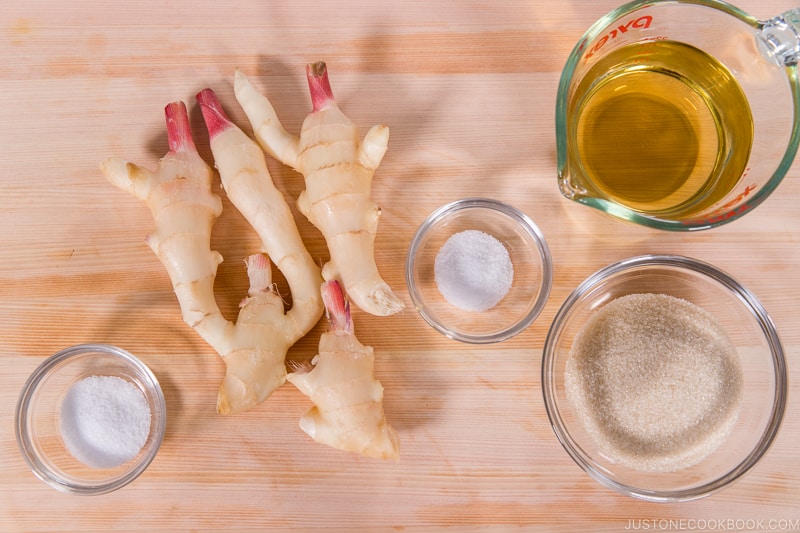
To Prepare the Ginger
- Using a knife (you can also use the back of the knife or a spoon), scrape off the brown spots and thin skin of 8 oz young ginger.
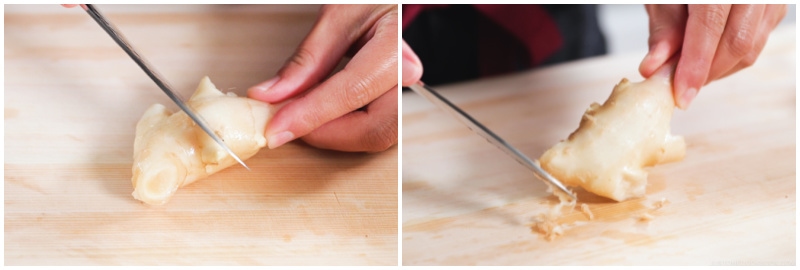
- Using a peeler, thinly slice the ginger. You can also use a mandoline. I prefer to use a peeler as it slices very thinly.
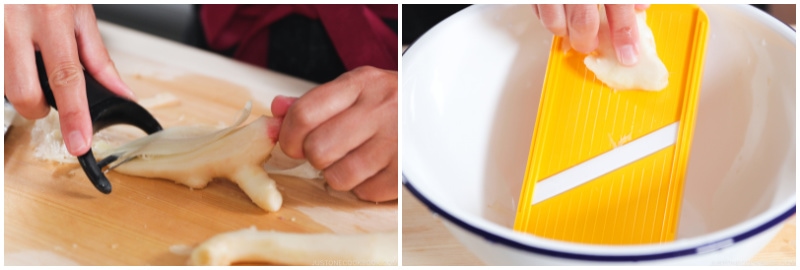
- When you can‘t slice the ginger anymore with the peeler/mandoline, use the knife to slice the rest thinly.
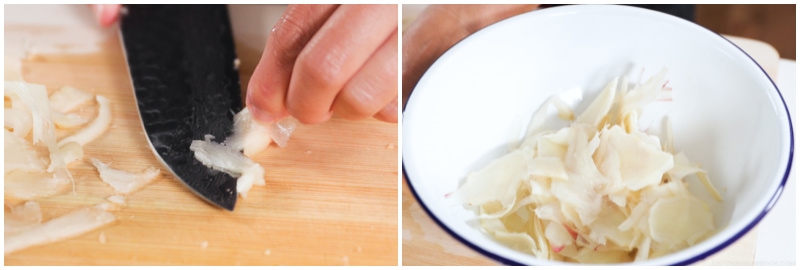
- Sprinkle 2 tsp Diamond Crystal kosher salt on the ginger slices and set aside for 5 minutes. The salt helps remove the moisture from the ginger so it can better absorb the pickling solution.
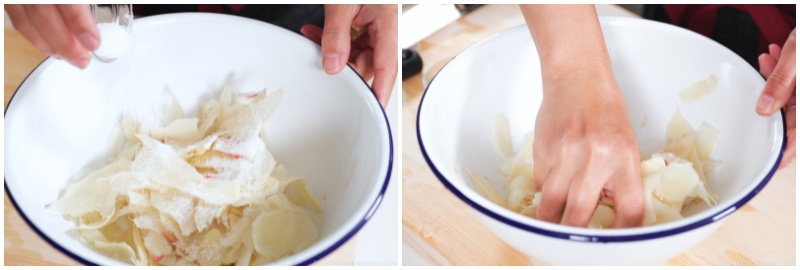
- Meanwhile, bring a medium pot of water to a boil. Once boiling, blanch the thinly sliced ginger for 1–2 minutes. If you want to keep it spicy, take it out after 1½ minutes. Tip: If you are using regular ginger (not young ginger), blanch it for 2–3 minutes to remove the extra spiciness.
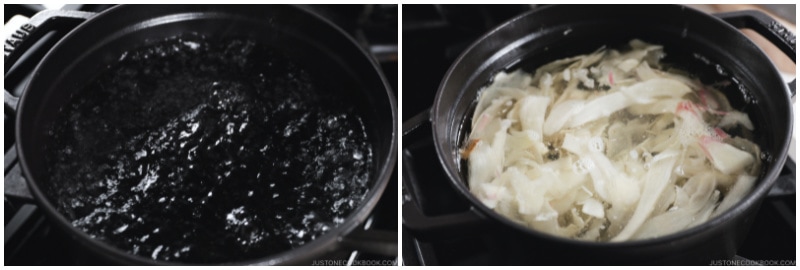
- Drain the ginger slices in a sieve. Let them cool slightly so you can handle them with your hands.
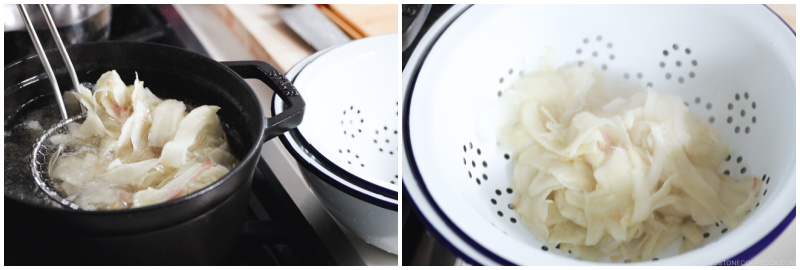
- With your clean hands, spread out the slices in a single layer over a large Japanese bamboo sieve (called bonzaru 盆ざる) or paper towel/wire rack. Set aside until it‘s completely cooled and dried out a bit more.
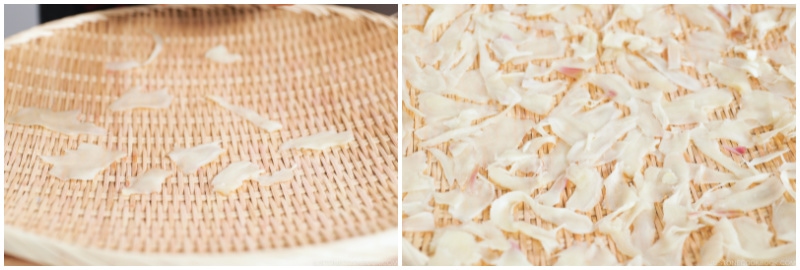
- Once cooled, squeeze the liquid from the ginger slices and put them in a sterilized airtight jar.
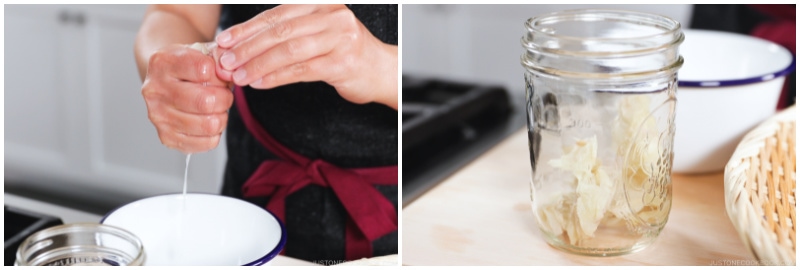
To Make the Sweet Vinegar (Amazu)
- In a small saucepan, add 1 cup rice vinegar (unseasoned), ½–¾ cup sugar, and 1 tsp Diamond Crystal kosher salt. Tip: DO NOT USE LESS SUGAR than specified because the ginger will not preserve well. The least you can use is ½ cup of sugar, and it is still quite tangy. If you prefer the taste of store-bought sushi ginger, use the higher measurement of sugar indicated.
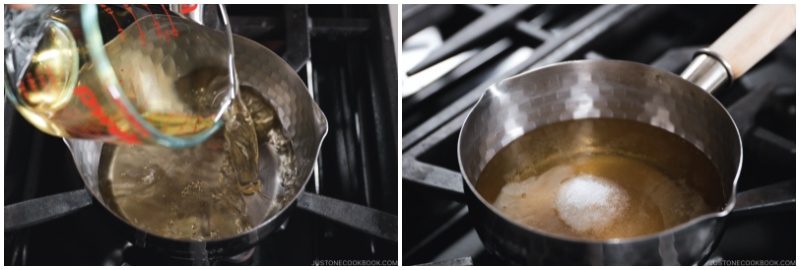
- Mix and bring it to a boil on medium heat. Cook the vinegar mixture until the strong vinegar smell has evaporated and the sugar has completely dissolved.
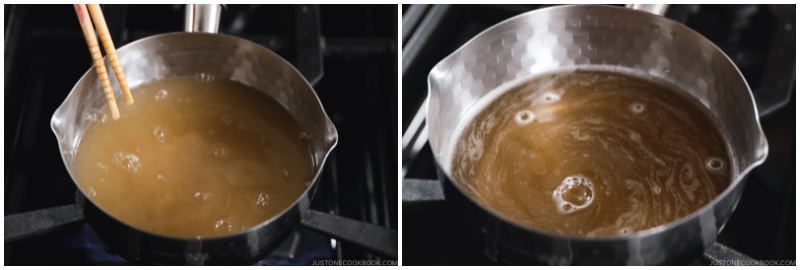
- Remove from the heat and let it cool slightly because the just-boiled liquid could break the glass jar. Pour the hot vinegar mixture into the jar with the ginger slices. Using clean chopsticks (or any utensil), mix it well together. Close the lid, let it cool completely, and refrigerate.
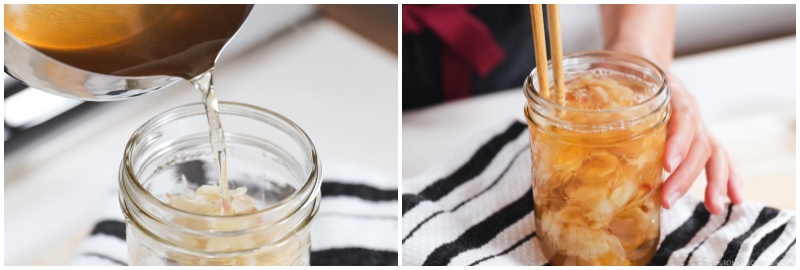
- After 4 hours or so, the ginger will turn slightly pink (see the photo below). I recommend waiting until the following day or a few more days to enjoy.
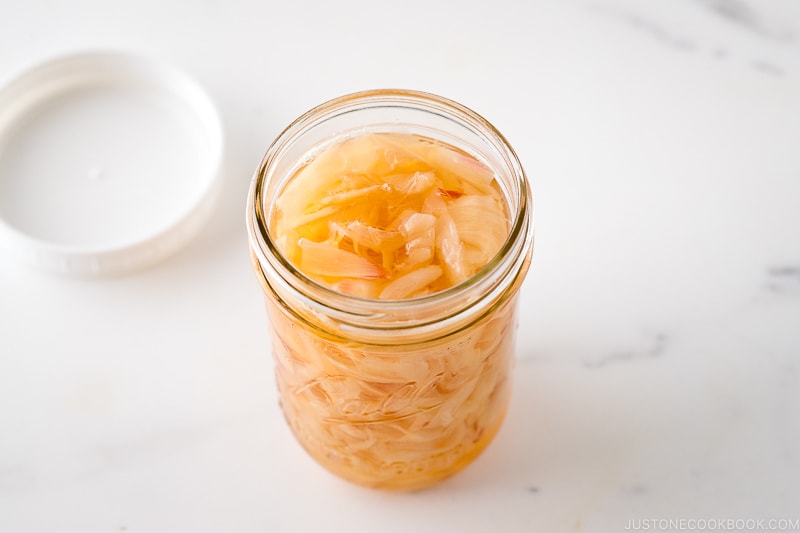
To Store
- Keep the pickled ginger in an airtight container and store in the refrigerator for up to one year. Always use clean utensils to remove the pickled ginger from the jar to avoid contamination and to help them keep for a long time.
Nutrition
Editor’s Note: This post was originally published on August 11, 2015. The images and content have been updated and a new video is added in June 2021.
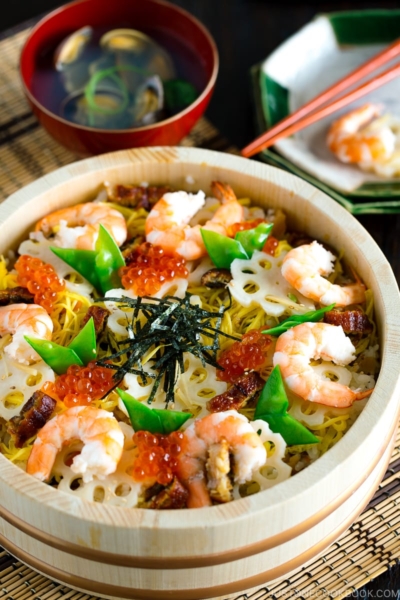
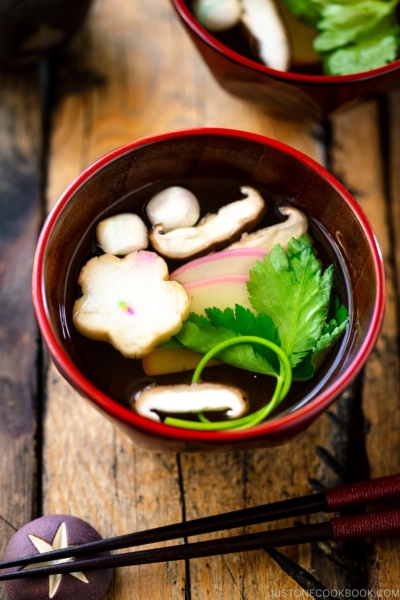
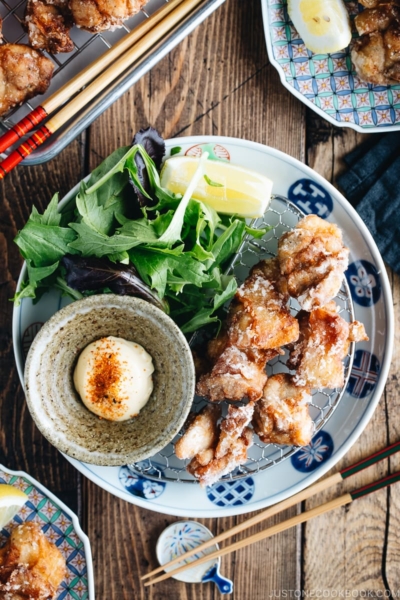
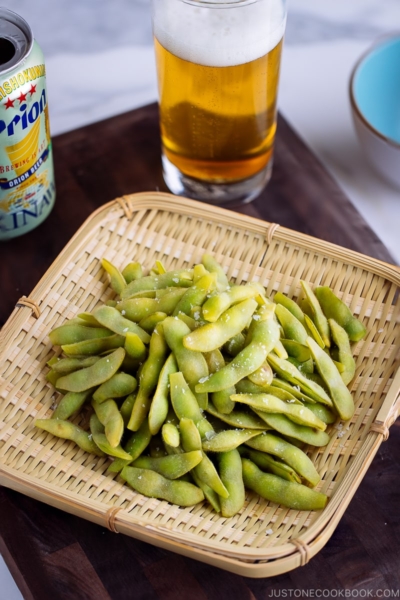




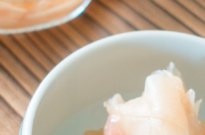
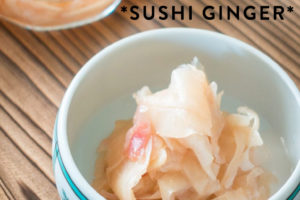
Hi there – I live in Australia, and have been making pickled ginger from your recipe for a long time. We love it, and it’s fantastic to always have some ready. I have tried experiments using apple cider vinegar, and also Italian vinegars. For anyone thinking it is a good substitute, you might be disappointed as it is far too strong. Japanese rice vinegar is more subtle and not as pungent as other vinegars. We often have difficulty getting young ginger where I live, so I sometimes use older ginger to pickle and use only in cooking. Hopefully we will be able to go back to Japan soon – we were there last year for our fourth visit! Thinking of our lovely Japanese friends in this awful time.
Hi Carol! Thank you so much for your kind feedback. I’m so happy to hear you enjoy this recipe so much. I agree with you. I always make sure people don’t take it lightly when I say rice vinegar… When I tried other types of vinegar (I only grew up with rice vinegar), I was shocked at how strong the vinegar tastes! Thank you for testing this with apple cider vinegar (I wasn’t fully sure) and Italian vinegars (never tried it). Your kind tips are truly appreciated!
Wonderful! Thank you for including all the important details, of season when young ginger comes out, Etc. very successful. Thank you. Arrigato gozimas.
Hi Laurie! You’re very welcome! Thank you for your kind feedback. 🙂
Can I substitute seasoned rice vinegar to rice vinegar?
Hi Mai! Yes, you can, but seasoned rice vinegar has salt and sugar in it, so adjust the taste accordingly. 🙂
love the ginger, i am eating it non stop instead of buying everyday. thank you.
Hi Judy! Thank you for trying my recipe! I’m so happy to hear you like it! 🙂
Wonderful recipe.
Thank you so much, Rita!
So, I didn’t have any ginger with the fresh little pink parts even though I used my own freshly harvested ginger. I really wanted it to be that pretty pink color so I threw in a couple wild hibiscus pods. It really did the trick. Just finished the recipe, thanks!!
Hi Su! Wow, what a great trick! Thanks for sharing it with us. I’m sure other readers will appreciate it. 🙂 Thank you for trying my recipe!
I was disappointed not to find this recipe in your book.
All you did was to make a reference to Pickled Red Ginger (Beni Shoga) in the “Pantry Basics” chapter.
Hi David! Do you mean my eBook? I’m sorry this recipe was not in my eBook. The eBook was published in 2013, so this recipe was not posted at that time. 🙁
Even in relatively close proximity to a Japanese supermarket, young ginger is currently out of season and very expensive, pound for pound, against matured ginger. I’ve considered modifying the recipe by leaving the salted ginger to sit for 10 minutes, rather than 5, and boiling for 3 full minutes, hopefully rendering it a little more tender and mild. Alternatively, one user suggested that Peruvian ginger is more tender, although I’ve also read that its flavor is actually even stronger than regular mature ginger.
Then there’s the matter of coloration. The idea of using plum peel is very interesting, although I wonder how the flavor and texture would change using some ume plum brine along with the rice wine vinegar? Is the flavor of red shiso very apparent in ume plum brine, or is it mostly the color?
Hi Chris! I agree, I’ve seen young ginger only few times here. You only need a small amount to make the solution pink, so I wouldn’t worry about the taste. 🙂
Can I use Apple cider vinegar to replace rice vinegar?
Hi Grace! I wish I can tell you… but I had never tried this recipe with apple cider so I can’t tell. It won’t taste like the Japanese pickled ginger tho, with apple vinegar.
Thank you for this recipe. I love pickled ginger. Do you think I could make this substituting the sugar with monk fruit granulated sweetener? I am on a very low carbohydrate diet.
Hi Lynne! I’ve never tried monk fruit granulated sweetner before so I can’t tell. Sorry… 🙁 Please give it a try and let me know. It should be sweeten, so if you use it to replace sugar, I assume it works?
Hi Namiko-san, would I be able to replace Japanese rice wine / vinegar with regular white distilled vinegar?
Hi Leng! You can – but if you compare with these two vinegars, they are different in strength… white distilled vinegar is def much stronger, and not mild like rice vinegar. So you might get strong kick when you make it with the same amount. I may suggest to use less and see how it goes. 🙂
Hi Namiko-san, thank you for taking time replying. I’ve noted the differences between rice vinegar vs. white distilled vinegar. I’ll invest in a bottle of rice wine vinegar since there are a lot of usage for it in Japanese cuisine. As mine just finished I was contemplating if I should get 1 :p
Hi Leng! Yeah, Japanese cooking always use rice vinegar. To make cucumber salad, sushi rice (to make sushi, not regular steamed rice), and dressings… very helpful to have one. 😉 Hope you enjoy!
Thanks Namiko-san for offering tips on how I can make use of rice vinegar. It’s really helpful and I appreciate it! You have a nice day there xxx
Thank you very much for this recipe. I will give it a try but will have to use the older ginger as the young you show in not avilable in Central Britany in France 🙁
Hi Vivienne! The regular ginger is spicier, but some of readers left comment above that it worked well. It might depends on one’s spicy level, preference and ginger type, but I hope it’ll come out well for you! 🙂
We had fresh young ginger with pink tips at our farmer’s market today, so I bought some and made this! Hoo! Wow! Was it ever strong! I only boiled it 1 1/2 minutes and maybe didn’t wait for the vinegar smell to entirely disappear. I love it!
Hi JtP! AWESOME!!!! It’ll become mild as the time goes by (so don’t eat all of it so soon haha). 🙂 Thank you for your kind feedback. Enjoy!!
I love pickled ginger. My husband and I are the only ones that like to eat it when Japanese restaurants serve it with sushi.
Wanted to tell you that I went to Thailand in April and the place that I loved the most was the Khlong Lat Mayon Floating Market. My daughter checked the different floating markets and this seemed to be the less touristy one. And the best Thai food we had was on the street outside our hotel. (5 dishes for $17!!) Enjoy Thailand!!
Hi Susan! I’m happy to hear you like pickled ginger! 🙂
Thank you for your recommendation! I saved the location in my map! Sounds like you had a fantastic trip!
Hi. Can’t i do it with matured ginger at all? ???? its very hard to find young ginger here in Lebanon ive never seen but matured ginger..
Hi Mariam! Matured ginger has very strong ginger taste (as you can imagine), so… the result will be quite different. Some JOC readers made with regular ginger, but I had never tasted it so I’m not sure how strong it was… Maybe boil a little longer than my recipe says, so you can remove the strong flavor before pickling? 🙂